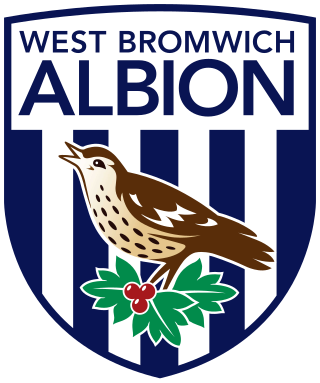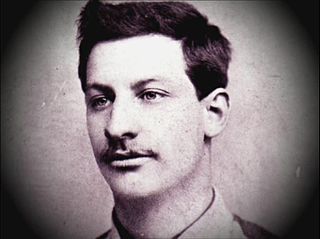
West Bromwich Albion Football Club is a professional association football club based in West Bromwich, West Midlands, England. They compete in the EFL Championship, the second level of the English football league system. The club was formed in 1878 and has played at its home ground, The Hawthorns, since 1900.

Jeffrey Astle was an English professional footballer who played the majority of his career as a centre-forward for West Bromwich Albion. Nicknamed "the King" by the club's fans, he played 361 games for them and scored 174 goals. He also won five caps for England without scoring.

William Isiah Bassett was an English association footballer, director, and club chairman who served West Bromwich Albion for over half a century.
Derek Tennyson Kevan was an English footballer. He spent the majority of his club career playing as a centre-forward for West Bromwich Albion, where he earned the nickname "The Tank". In 1961–62 he was joint leading scorer in Division One – alongside Ray Crawford of Ipswich Town – with 33 goals. He also won 14 caps for the England national team, scoring a total of eight goals, including two in the 1958 FIFA World Cup Finals.
West Bromwich Albion Football Club are an English football club based in West Bromwich. The club's history dates back to its formation in 1878 as West Bromwich Strollers by workers from Salter's Spring Works in West Bromwich. The team was renamed West Bromwich Albion in 1880. Albion have played their home games at The Hawthorns since 1900.

The 1931 FA Cup final was a football match between West Bromwich Albion and Birmingham, played on 25 April 1931 at the original Wembley Stadium in London. The showpiece event was the final match of the 1930–31 staging of English football's primary cup competition, the Football Association Challenge Cup. The match was the 56th FA Cup Final, the ninth to be played at Wembley.

The 1954 FA Cup final was a football match between West Bromwich Albion and Preston North End, played on 1 May 1954 at the original Wembley Stadium in London. It was the final match of the 1953–54 staging of English football's primary cup competition, the Football Association Challenge Cup. The match was the 73rd FA Cup Final and the 26th to be played at Wembley.

The 1970 Football League Cup Final took place on 7 March 1970 at Wembley Stadium with an attendance of 97,963. It was the tenth Football League Cup final and the fourth to be played at Wembley. It was contested between Manchester City and West Bromwich Albion, with City winning their first of the two trophies that season; on 29 April they would win the 1970 European Cup Winners' Cup final against Górnik Zabrze 2–1.
Joseph Peter Kennedy was an English professional footballer who played at centre half for the majority of his career, virtually all of which was spent at West Bromwich Albion.

Joseph James Wilson was an English footballer who played at outside left. During his 15-year playing career he represented several teams from the West Midlands region, both as an amateur and a professional. He gained an FA Cup winners medal with West Bromwich Albion and was the scorer of the club's first ever goal in The Football League.

Thomas Patrick Magee was an English professional footballer who played as a wing half. He made more than 400 appearances during his 15 years at West Bromwich Albion. He also won five England caps.
The 2001–02 season was West Bromwich Albion's 106th season in The Football League. The team had lost in the playoff semi-final to Bolton Wanderers in 2000–01, meaning that they would be playing in the Football League First Division for the ninth consecutive season, their 33rd season in total at the second level of English football.
John Talbut was an English football defender.
The 1885–86 season was the eighth season in the history of West Bromwich Albion Football Club. In what was their inaugural season as a professional club, Albion moved to the Stoney Lane ground after leaving their previous home at Four Acres. The team also changed the colour of its kit, wearing blue and white striped jerseys for the first time. As league football had not been introduced in England at the time, the team competed solely in cup competitions and friendly matches throughout the season, playing 52 matches in total.
The 1884–1885 season was 7th season of West Bromwich Albion Football Club. It was their third and final season at the Four Acres and their last season as an amateur club. Continuing the trial of various coloured kits during the club's early years, the players wore cardinal red and blue halved shirts. The club reached the FA Cup quarter-final for the first time, played in the semi-finals of the Staffordshire Senior Cup and Birmingham Charity Cup and were eliminated from the Birmingham Senior Cup at the third round stage.
The 1886–87 season was the ninth season in the history of West Bromwich Albion Football Club. The club reached the FA Cup final for the second successive season, but again finished as runners-up, losing 0–2 to local rivals Aston Villa. Albion also reached the final of two regional cup competitions, winning the Staffordshire Senior Cup and finishing as runners-up in the Birmingham Senior Cup. In addition, they took part in the Walsall Senior Cup and Birmingham Charity Cup, as well as playing a number of friendly matches.
During the 1978–79 English football season, West Bromwich Albion F.C. competed in the Football League First Division. The club enjoyed their highest league finish since 1953–54 when they were runners-up.
The 1887–88 season was the 10th season in the history of West Bromwich Albion Football Club. The club reached the FA Cup final for the third successive season and won the competition for the first time, beating Preston North End 2–1. Albion also competed in four local cup competitions, winning the Walsall Senior Cup and West Bromwich Charity Cup and finishing as runners-up in the Birmingham Senior Cup and Staffordshire Senior Cup. Due to a congested fixture list, the club refused to take part in the Birmingham Charity Cup.








